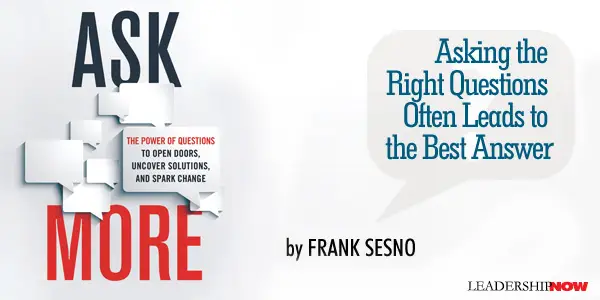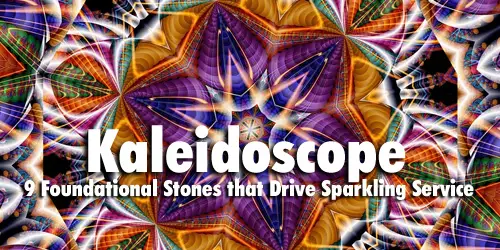 Leading Blog | Posts by Month |
 Leading Blog | Posts by Month |
02.28.17

LeadershipNow 140: February 2017 Compilation
See more on
Posted by Michael McKinney at 08:30 AM
02.27.17

Mastering Civility
Civility costs nothing, and buys everything. CIVILITY has a way of winning people over and garnering influence. Civility isn’t just the absence of incivility. In Mastering Civility, Christine Porath explains that “Civility in the fullest sense requires something more: positive gestures of respect, dignity, courtesy, or kindness that lift people up.” Incivility impacts our health and performance. It depletes our “immune system, causing cardiovascular disease, cancer, diabetes, and ulcers.” It also robs us of our “cognitive resources, hijacks our performance and creativity, and sidelines us from our work. Even if we want to perform at our best, we can’t, because we’re bothered and preoccupied by the rudeness.” Incivility is contagious. “When you’re exposed to hostility or aggression, you behave differently. Incivility sneaks into your subconscious. It’s easy to see how plagues of incivility can take shape and spread.” But you don’t have to succumb to incivility. “When you follow a rude experience with a polite one, the polite one ‘overwrites’ the rude one, loosening the hold it has on your mind.” Civility starts with a few basic behaviors and it grows from there. Simple things like saying please and thank you make a difference in how we are perceived by others and the influence we have on them. “Most of us are in a hurry to prove our competence, but warmth contributes significantly more to others’ evaluations. Warmth is the pathway to influence.” Other basic behaviors include acknowledging people and listening. They signal caring, commitment and connection. Show respect for others by sharing resources, the limelight, and positive feedback. “The highest performers offer more positive feedback with their peers; in fact, high-performing teams share six times more positive feedback than average teams. Meanwhile, low-performing teams share twice as much negative feedback than average teams.” What if you are the victim of incivility? When someone is being uncivil to you it’s easy to let your emotions take over. It’s easy to get sucked in to their incivility. Porath advises you to avoid the temptation to get even. It’s not a win for you. The best advice has nothing to do with them and everything to do with you. How will you choose to interpret it? Here are a few of her thoughts: When you experience incivility, your sense of thriving comes into play in a particular way: by making it easier for you to reframe the negativity of the event so that it isn’t nearly as destructive. Everyone would agree that we should be civil and we recoil when we see others engaged in it, yet incivility has become more commonplace. Somehow we feel justified being uncivil when things don’t go our way. And it costs us all. Uncivil behavior does not generate greater influence no matter how loud you are. Most leadership failures can be attributed to abrasive or arrogant approaches to others. Uncivil leaders eventually undermine their own potential. Are you civil? Porath offers a quick civility assessment online. 
Posted by Michael McKinney at 08:44 AM
02.24.17

Asking the Right Questions Often Leads to the Best Answer
BEING A LEADER often means making far-reaching decisions that require major investments of time, resources, and energy. Complete certainty is seldom possible. Competing agendas often complicate the process. The future is never something you can take for granted. So you need to be as dispassionate as possible in how you examine opportunities and vulnerabilities. Knowing how to ask the right questions is essential to sorting through the options, clarifying objectives and making the best decision possible. Good leaders are adept at asking strategic questions. These are the types of questions that deepen understanding and look over the horizon. By asking more of these questions – of yourself and others -- you articulate goals, set benchmarks and assess risk. You become a better thinker and a smarter leader. Strategic questions zoom out and look at the big picture. They ask about long-term goals, interests, and priorities. They consider alternatives, consequences, and downsides. They sharpen the focus on the larger objective and clarify what it will take to get there. Strategic questions break into distinct categories. Big Question: Cost and Consequence: Trade-offs: Alternatives: Define Success: Listen: Try: CEOs are often the most successful people. Many of them possess a hidden skill – the ability to ask questions that help envision the future, assess risk and reward, and anticipate trends.  
Posted by Michael McKinney at 07:25 AM
02.22.17

Kaleidoscope: 9 Foundational Stones that Drive Sparkling Service PEOPLE DON'T talk about good service, “they boast about unique, captivating services experiences.” In Kaleidoscope, Chip Bell explores what makes an experience so good that people want to tell their friends about it. What makes people become zealous advocates of your business? Creating these kinds of customer experiences works in much the same way a kaleidoscope works. Every time you turn a kaleidoscope you get a unique image, but the stones inside that form those images never change. They are the core of what makes the kaleidoscope work. Kaleidoscope is about these basic, foundational "stones" and concepts that should drive innovative customer service. These stones can be presented in unique combinations that will drive brilliant service. Bell presents nine stones that form the basis of sparkling innovative service: Enchantment: How can you add a little magic? What could your service experience smell like, sound like, feel like, look like, taste like if you wanted to truly excite your customers in a fashion that sticks in their memory? Grace: Honor your customer. Graceful service is an assertion, not a response. It’s an attitude not a tactic. Customers treated with goodness assume the behavior and attitude of goodness. Be the giver of hope your customers become. Respect is not what you believe; it is what you show. You can start igniting grace with a simple, “I am here to serve and daringly make a difference in your life.” Trust: Honor and trust are the lifeblood of repeat business. Treat different customers differently. One-size-fits-all treatment shows ignorance of their uniqueness and indifference to learning about them. Find ways to make every customer’s experience feel like it has his or her monogram on it. Generosity: Adopt an attitude of abundance. Give more than is expected. Great service means caring so much about the experience you are authoring or the product you are caretaking that you are willing to invest more in it, purely in the pursuit of the remarkable. Truth: Truth telling shortens the distance between people. It frees customers from anxiety and caution. It triggers a potent connection with the humanity in each of us. Everything in your customer’s experience is personal. Corporate speak and sanitized legalese communication, by definition, violate that principle. Mercy: Mercy’s presence in a relationship comes when it is being tested, challenged, or disputed. Mercy is more than forgiveness. It is a relationship surrendering to what it could be rather than controlling or containing what it is. It is neither an expression of pity nor an air of tolerance. Rather, it is expanding the boundaries of the relationship to allow it to reform, renew, and reward. Alliance: Customers enjoy being a partner. Great partnerships care about fairness, not a perfect fifty-fifty split. Great partnerships have built-in shock absorbers. They affirm their relationships more through ebb and flow than give and take. Examine your business practices. Do you make customers go to the nth degree to get what they need? Ease: The key to innovative service is appreciating its complexity, understanding its impact, and paying attention to the detail that rigger customer angst and discomfort. Be your customers’ pathfinder to ease by examining their experience through their eyes, not yours. Passion: Passion-filled service is fundamentally about commitment. It is the outcome that results from the fervor to be all-in, to serve without reluctance. identify a service “souvenir” – a small, delightful takeaway that could extend the customer’s experience beyond adieu. Bell’s focus in Kaleidoscope is delivering customer service experiences that are value-unique, not just value-added. Deliver a masterpiece. 
Posted by Michael McKinney at 07:58 AM
02.20.17

Ryan Blair’s Five Rules for Being a Rock Star RYAN BLAIR is a serial entrepreneur and the co-founder and CEO of ViSalus Sciences. In Rock Bottom to Rock Star he shares lessons from his own journey. Not surprisingly, the journey begins with taking personal responsibility. Without it you can’t move up from your rock bottom. You are your own competition. Blair explains, “There is a way to shape everything in life so that it serves you and drives you toward success.” In whatever you chose to do “your timeline will be filled with smile sand cries. Ultimately, success will be determined by whether or not you have the right psychology to control them.” Here are Blari’s five rules for being a rock star: Rule 1: Don’t listen to the noise. Especially in this day and age, any fool with a mobile phone and a social media account thinks he’s an expert, so don’t listen to useless, negative messaging, and only take advice from those who are qualified to give it. Rule 2: Don’t believe your own hype. The moment you start celebrating, you’ve left the stage. It wasn’t celebration that made you a rock star, it was hard work. Remember that. Rule 3: Practice. There will be times where you’re going to get rusty, and you’re going to ask yourself, can I still do this? You have to get out there, play, rehearse, get feedback from your “audience,” and modify your performance. Rule 4: Surround yourself with the right musicians. You have to constantly assess the people you choose to hang with. Are they helping you move forward or are they just along for the ride? Are they building you up, or tearing you apart? I’ve lost relatives over this. Rule 5: Always remember where you came from. 
Posted by Michael McKinney at 01:22 AM
02.17.17

Freeing Yourself from Yourself
TOM ASACKER always makes you think. Life is not scripted but we live it as though it were. In doing so, we create boxes that we operate within without ever really seeing the possibilities. “We’re confined in mental prisons of our own creation.” We make these scripts up or others make them up for us and eventually we come to believe them. And the problem is we think that is reality. It’s that story inside our head that keeps us from flourishing as we should—a life that moves us. We are sabotaging ourselves. We act more like Coleridge and less like Keats. In I Am Keats, Asacker develops a metaphor for two worldviews as expressed through the poetry of two 19th century poets: Coleridge and Keats. Keats was passionate. He was moved by his senses and imagination. Capable of being in uncertainties, mysteries and doubts, he was uninhibited, open, and without judgment. We are conditioned – perhaps predisposed – to live in Coleridge’s worldview. Coleridge wants to predict an unknowable future. He is logic, order, control and progress. Coleridge wants you to live a productive and mistake-free life. “He is an expert craftsman, skilled in the rights and wrongs of the world, and turned on by the desire for risk aversion, accumulation and conformity.” Neither is right or wrong but we need to be aware of the dynamic between the two or we never really live. We never see the possibilities. Knowing is safe. Being is frightening – “a dynamic dance with reality.” But we are held captive by our beliefs—what we believe to be reality. “Here’s the thing about our beliefs. We don’t want them pointed out to us. We don’t want to have our soothing stories interrupted. We don’t want to be woken up from our script, from our reassuring routines. Otherwise, we’ll have to think. And then, heaven forbid, we may have to change. Asacker writes, “Let go of your incessant desire to know, to predict and influence, and instead be willing to experience the mystery of the present without corrupting it with questions.” When you allow yourself to become more like Keats, “you find yourself being pulled deeper and deeper into a process that creates serendipitous connections and refines your perceptions. Your old eyes adjust to a new world, and you become more creative and discerning.” Experience the moment. “Your present creates the meaning of your past.” I Am Keats is a book for our times. It is a philosophy says Asacker. “Magic, then logic. Heart, then head.” Try it. More at: IAmKeats.com 
Posted by Michael McKinney at 08:33 AM
02.01.17

First Look: Leadership Books for February 2017Here's a look at some of the best leadership books to be released in February.    
For bulk orders call 1-800-423-8273  Build your leadership library with these specials on over 100 titles. All titles are at least 40% off the list price and are available only in limited quantities. "It is what you read when you don't have to that determines who you will be when you can't help it." — Oscar Wilde
Posted by Michael McKinney at 09:32 AM
|
BUILD YOUR KNOWLEDGE


How to Do Your Start-Up Right STRAIGHT TALK FOR START-UPS 
Grow Your Leadership Skills NEW AND UPCOMING LEADERSHIP BOOKS 
Leadership Minute BITE-SIZE CONCEPTS YOU CAN CHEW ON 
Classic Leadership Books BOOKS TO READ BEFORE YOU LEAD |
|